Contact:
Nordica Holochuck, NYSG's Hudson Estuary Specialist E:
nch8@cornell.edu
New York, NY, June 12, 2014 - One Sunday morning late this past April, some two dozen teachers from New York City, Long Island and Westchester schools made their way to the Teachers College at Columbia University on New York's Upper West Side to sharpen their skill set while earning professional development credits.
"This was a good networking opportunity for colleagues new and old to find out more about some unique and innovative education techniques to use when teaching marine science related subjects and programs," said New York Sea Grant (NYSG) Hudson Estuary Specialist
Nordica Holochuck, who coordinated this third workshop of its kind in as many years.
Named a Marine Science Share-a-thon, the partnership program with the New York State Marine Education Association (NYSMEA) featured seven hands-on presentations, which included classroom-friendly water quality monitoring, salt and freshwater experiments, buoyancy and boat building, Google Earth for coastal education, a 411 on basic fisheries anatomy, and sand and oil spill activities.
— Paul C. Focazio, NYSG's Web Content Manager
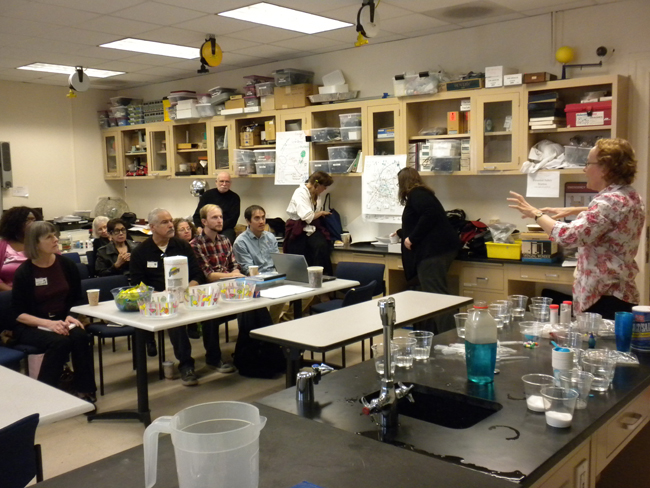
During this interactive "Share-A-Thon," attendees shared their favorite hands-on marine-science-related activities, techniques and lesson plans with K-12 classroom teachers and community environmental educators.
Photo: Paul C. Focazio, NYSG.
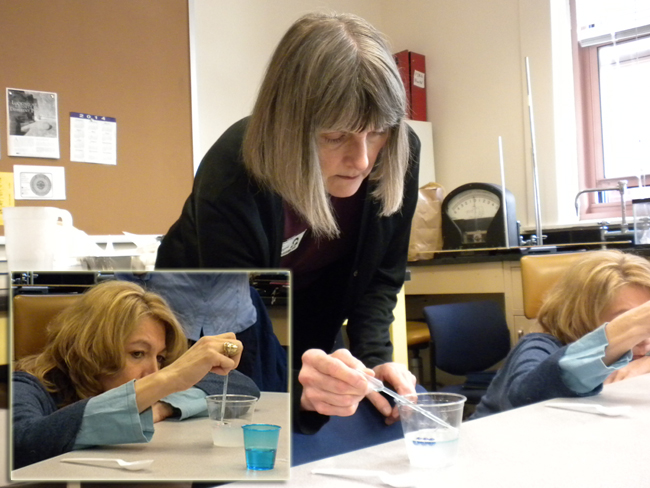
Fresh or Salt? This laboratory-in-the-classroom exercise can help students understand estuaries, which contain a mixture of fresh and salt water.
Photos: Paul C. Focazio, NYSG.
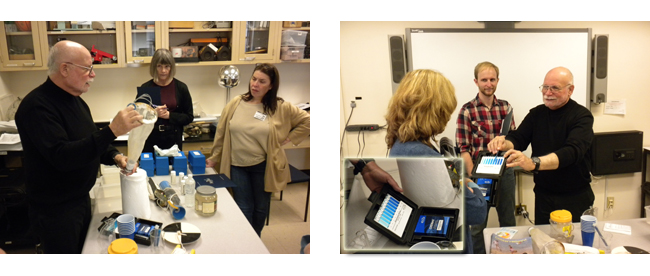
Testing the Waters: Educators came away with some new techniques to easily and inexpensively test drinking, fresh and salt waters for common parameters. Also discussed by lead
Lou Siegel were monitoring and research programs and methods to publish classroom results on the Web.
Photos: Paul C. Focazio, NYSG.
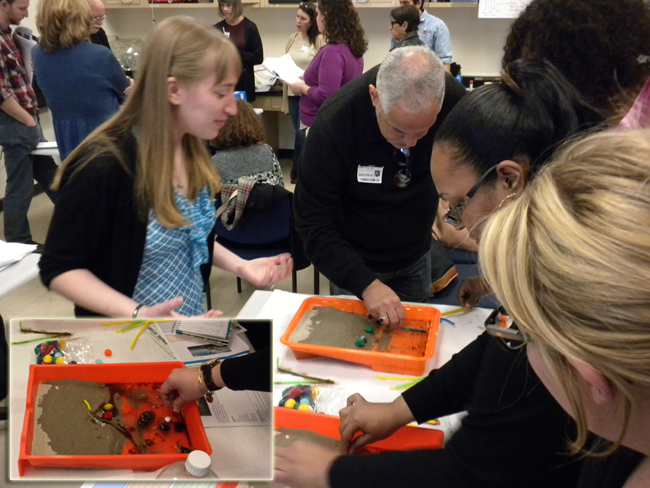
Another lesson plan begins with students building a small-scale beach environment on a paint tray, then adding oil to water to mimic an oil spill before using a variety of objects to try and clean up the slick. "We want teachers and students to figure out ways to clean up the oil using different materials that mimic real life methods and then reflect on what methods worked best and relate to how people actually clean up oil spills in waterways," says NYSMEA President
Meg Marrero.
Photos: Paul C. Focazio, NYSG.
NYSMEA educators have had some related field experience: Several times in the last few years, a group NYSMEA members and NYSG-ers traveled to southern Louisiana for restoration trips that highlighted the importance of the Gulf of Mexico, its seafood, oil and wetlands. NYSMEA educators and NYSG staff will return for a second trip later next month. For more, see January 2013's related news item, "
New York Volunteers Augment Restoration’s Success in Southern Louisiana."
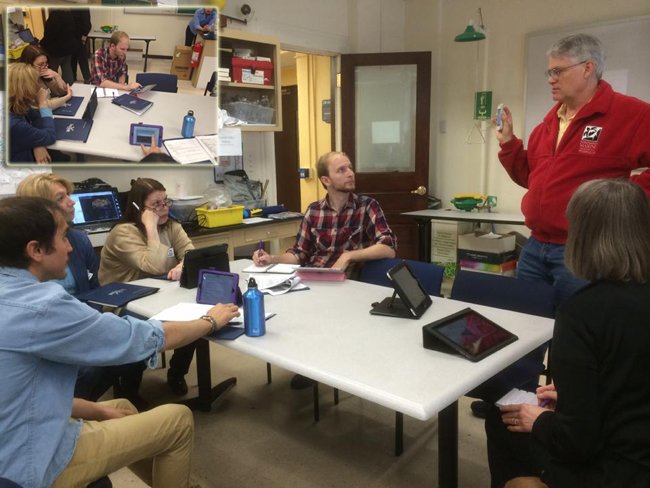
How do we inspire enthusiasm for understanding and mapping shorelines and waterways? Through hands-on demonstrations using geospatial applications like Google Earth that are readily available for use on electronic tablets.
Photos: NYSMEA.
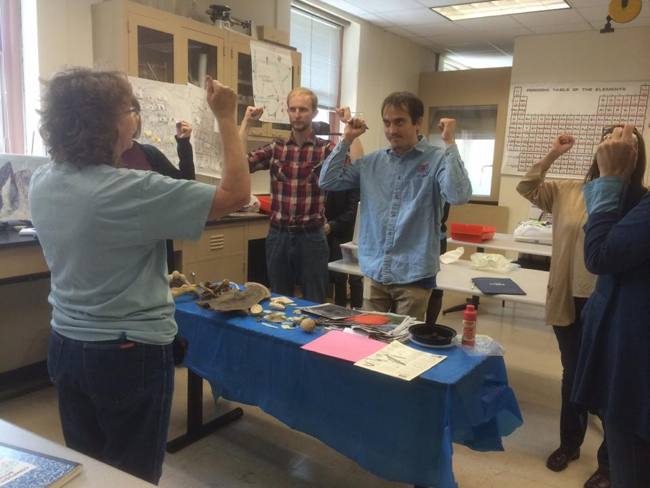 Merryl Kafka
Merryl Kafka, former Education Director at the New York Aquarium, explored the world of fish - from evolution and adaptations for survival to an examination of scales and body parts and a fish dissection.
Photo: NYSMEA.

What Makes That Boat Float? This do-it-yourself maritime activity examines the properties of buoyancy and boat building.
Photo: Paul C. Focazio, NYSG.
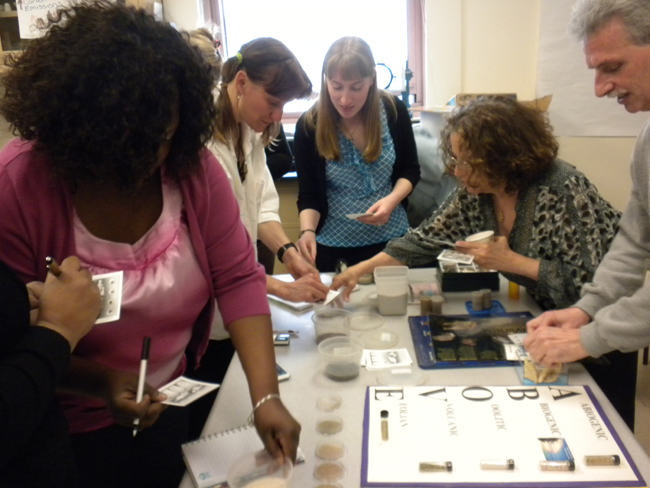
Why does sand come in many colors? How is sand formed? What animals live in sand? These are some of the questions studied in the "sand in the classroom" session. "Ideally, we want teachers to bring their students for a walk on the beach to explore the world of sand," said
Bob Cummings of the New York Aquarium. "But if you're not near a beach or just can't get their on your budget, the idea here is to bring it back to your classroom through a hands-on activity that will excite and potentially inspire the minds of future marine geologists."
Photo: Paul C. Focazio, NYSG.
More Info: New York Sea Grant and NYSMEA
NYSMEA promotes marine awareness and encourages the growth and exchange
of instructional resources within the scientific, commercial, and
educational communities. Members include educators from all levels:
museum, aquarium, and environmental center staff, research scientists,
laboratory technicians and those with interests in SCUBA, fishing,
boating, maritime history, folklore, archeology and the arts. More at
www.nysmea.org.
New York Sea Grant (NYSG), a cooperative program of Cornell University
and the State University of New York, is one of 33 university-based
programs under the National Sea Grant College Program (NSGCP) of the
National Oceanic and Atmospheric Administration (NOAA). The NSGCP
engages this network of the nation’s top universities in conducting
scientific research, education, training and extension projects designed
to foster science-based decisions about the use and conservation of our
aquatic resources. Through its statewide network of integrated
services, NYSG has been promoting coastal vitality, environmental
sustainability, and citizen awareness about the State’s marine and Great
Lakes resources since 1971.
For updates on Sea Grant activities:
www.nyseagrant.org has RSS,
Facebook,
Twitter, and
YouTube links. NYSG also offers a free e-list sign up via
www.nyseagrant.org/coastlines for
NY Coastlines, its flagship publication, which, in 2014, merges with the program's e-newsletter,
Currents.
NY Coastlines is published several times a year.